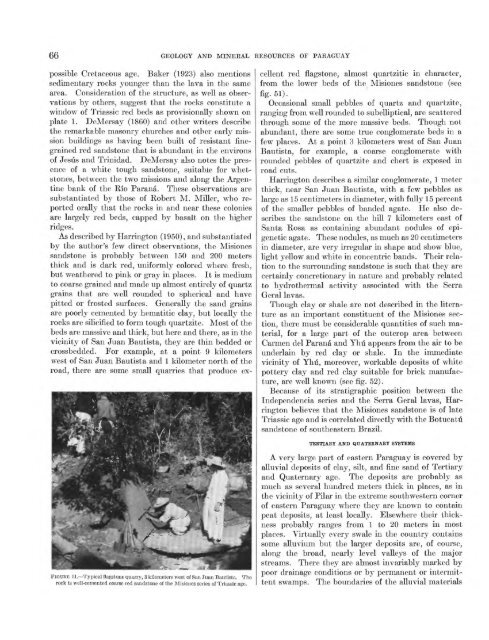Geology and Mineral Resources of Paraguay A Reconnaissance
Geology and Mineral Resources of Paraguay A Reconnaissance
Geology and Mineral Resources of Paraguay A Reconnaissance
- No tags were found...
Create successful ePaper yourself
Turn your PDF publications into a flip-book with our unique Google optimized e-Paper software.
66possible Cretaceous age. Baker (1923) also mentionssedimentary rocks younger than the lava in the samearea. Consideration <strong>of</strong> the structure, as well as observationsby others, suggest that the rocks constitute awindow <strong>of</strong> Triassic red beds as provisionally shown onplate 1. DeMersay (1860) <strong>and</strong> other writers describethe remarkable masonry churches <strong>and</strong> other early missionbuildings as having been built <strong>of</strong> resistant finegrainedred s<strong>and</strong>stone that is abundant in the environs<strong>of</strong> Jesus <strong>and</strong> Trinidad. DeMersay also notes the presence<strong>of</strong> a white tough s<strong>and</strong>stone, suitable for whetstones,between the two missions <strong>and</strong> along the Argentinebank <strong>of</strong> the Rio Parana. These observations aresubstantiated by those <strong>of</strong> Robert M. Miller, who reportedorally that the rocks in <strong>and</strong> near these coloniesare largely red beds, capped by basalt on the higherridges.As described by Harrington (1950), <strong>and</strong> substantiatedby the author's few direct observations, the Misioness<strong>and</strong>stone is probably between 150 <strong>and</strong> 200 metersthick <strong>and</strong> is dark red, uniformly colored where fresh,but weathered to pink or gray in places. It is mediumto coarse grained <strong>and</strong> made up almost entirely <strong>of</strong> quartzgrains that are well rounded to spherical <strong>and</strong> havepitted or frosted surfaces. Generally the s<strong>and</strong> grainsare poorly cemented by hematitic clay, but locally therocks are silicified to form tough quartzite. Most <strong>of</strong> thebeds are massive <strong>and</strong> thick, but here <strong>and</strong> there, as in thevicinity <strong>of</strong> San Juan Bautista, they are thin bedded orcrossbedded. For example, at a point 9 kilometerswest <strong>of</strong> San Juan Bautista <strong>and</strong> 1 kilometer north <strong>of</strong> theroad, there are some small quarries that produce ex-cellent red flagstone, almost quartzitic in character,from the lower beds <strong>of</strong> the Misiones s<strong>and</strong>stone (seefig. 51).Occasional small pebbles <strong>of</strong> quartz <strong>and</strong> quartzite,ranging from well rounded to subelliptical, are scatteredthrough some <strong>of</strong> the more massive beds. Though notabundant, there are some true conglomerate beds in afew places. At a point 3 kilometers west <strong>of</strong> San JuanBautista, for example, a coarse conglomerate withrounded pebbles <strong>of</strong> quartzite <strong>and</strong> chert is exposed inroad cuts.Harrington describes a similar conglomerate, 1 meterthick, near San Juan Bautista, with a few pebbles aslarge as 15 centimeters in diameter, with fully 15 percent<strong>of</strong> the smaller pebbles <strong>of</strong> b<strong>and</strong>ed agate. He also describesthe s<strong>and</strong>stone on the hill 7 kilometers east <strong>of</strong>Santa Rosa as containing abundant nodules <strong>of</strong> epigeneticagate. These nodules, as much as 20 centimetersin diameter, are very irregular in shape <strong>and</strong> show blue,light yellow <strong>and</strong> white in concentric b<strong>and</strong>s. Their relationto the surrounding s<strong>and</strong>stone is such that they arecertainly concretionary in nature <strong>and</strong> probably relatedto hydrothermal activity associated with the SerraGeral lavas.Though clay or shale are not described in the literatureas an important constituent <strong>of</strong> the Misiones section,there must be considerable quantities <strong>of</strong> such material,for a large part <strong>of</strong> the outcrop area betweenCarmen del Parana <strong>and</strong> Yhu appears from the air to beunderlain by red clay or shale. In the immediatevicinity <strong>of</strong> Yhu, moreover, workable deposits <strong>of</strong> whitepottery clay <strong>and</strong> red clay suitable for brick manufacture,are well known (see fig. 52).Because <strong>of</strong> its stratigraphic position between theIndependencia series <strong>and</strong> the Serra Geral lavas, Harringtonbelieves that the Misiones s<strong>and</strong>stone is <strong>of</strong> lateTriassic age <strong>and</strong> is correlated directly with the Botucatus<strong>and</strong>stone <strong>of</strong> southeastern Brazil.TERTIARY AND QUATERNARY SYSTEMSFIGTJKE 51. Typical flagstone quarry, 3 kilometers west <strong>of</strong> San Juan Bautista. Therock is well-cemented coarse red s<strong>and</strong>stone <strong>of</strong> the Misiones series <strong>of</strong> Triassic age.A very large part <strong>of</strong> eastern <strong>Paraguay</strong> is covered byalluvial deposits <strong>of</strong> clay, silt, <strong>and</strong> fine s<strong>and</strong> <strong>of</strong> Tertiary<strong>and</strong> Quaternary age. The deposits are probably asmuch as several hundred meters thick in places, as inthe vicinity <strong>of</strong> Pilar in the extreme southwestern corner<strong>of</strong> eastern <strong>Paraguay</strong> where they are known to containpeat deposits, at least locally. Elsewhere their thicknessprobably ranges from 1 to 20 meters in mostplaces. Virtually every swale in the country containssome alluvium but the larger deposits are, <strong>of</strong> course,along the broad, nearly level valleys <strong>of</strong> the majorstreams. There they are almost invariably marked bypoor drainage conditions or by permanent or intermittentswamps. The boundaries <strong>of</strong> the alluvial materials
















